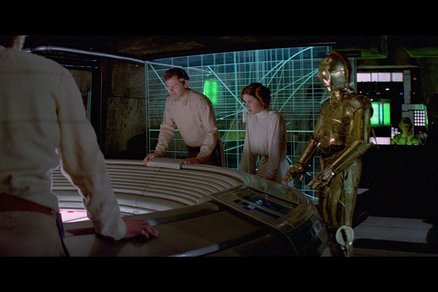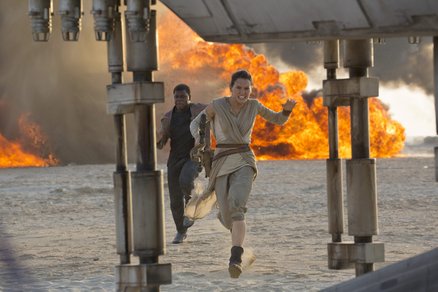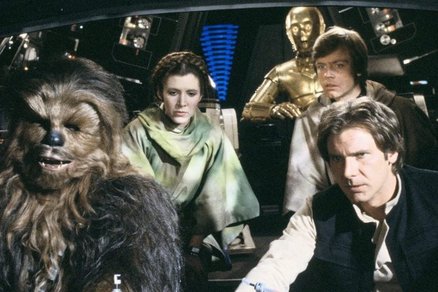Are you planning on watching Star Wars with your kids? Check out the age rating and content advice for each film, as well as some ideas for topics to discuss once the credits roll.

Star Wars Episode IV: A New Hope
U for mild sci-fi action
Star Wars Episode IV: A New Hope (1977) is a science fiction film about a young man called Luke Skywalker, who joins forces with a Jedi Knight, a cocky pilot, a Wookiee and two droids to save the galaxy from the Empire’s world-destroying battle station, while also attempting to rescue Princess Leia from the evil Darth Vader.
violence
There is some mild violence, but all in a clear fantasy setting. Most of the violence is theatrical and bloodless, lacking in any strong detail. The strongest examples include sight of a man using a light saber in a bar brawl and slicing off an alien's arm; we briefly see the arm on the floor. There is also the sight of some charred bodies after a family is attacked, and some scuffles and fights with fantasy weapons including ray guns and light sabers. The baddie Darth Vader also grabs subordinates and enemies by the neck, killing them.
The film also includes some explosions and space battle scenes, as spaceships are shot from the sky and hit during a battle sequence.

Star Wars Episode V: The Empire Strikes Back
PG for moderate violence, mild threat
Star Wars Episode V: The Empire Strikes Back is a sci-fi action fantasy adventure, from 1980, in which the Rebels continue their fight against the Empire.
violence
A man's hand is chopped off using a lightsaber and, during a dream sequence, a man is decapitated. Both moments of violence are brief and without any sight of blood or injury detail. There are also scenes of fantasy violence including dogfights, lightsaber fights, scenes of hand-to-hand combat in which men are punched, and sequences in which men are shot with blasters. It is implied a man is tortured.
threat and horror
Threatening scenes including those in which a man is kidnapped by a snow creature, and a sequence in which a man is forced into a small chamber and encased in a substance which freezes him. There are also scenes in which men are attacked and, during battles, their lives are endangered.
injury detail
There is limited sight of blood and injury in the aftermath of violence, including blood on a man's face and a bloody stump when a creature is killed.

Star Wars Episode VI: Return Of The Jedi
PG for moderate violence, mild threat
Star Wars Episode VI: Return Of The Jedi (1983) is about the Rebels’ attempt to destroy the Second Death Star, while Luke Skywalker tries to bring his father back to the Light Side of the Force.
violence
A man is repeatedly electrocuted and reacts in pain. A villain's hand is cut off at the wrist; however, there is limited detail. A woman is fed to a fantastical creature. A man is thrown to his death; however, his death is not shown on screen. There are also laser gun fights, aerial dogfights, and fight scenes which include masked blows and the occasional use of improvised weapons.
threat and horror
A woman is chained by the neck to an alien creature. Characters are threatened with being fed to a creature. There are also scenes in which characters are threatened at gunpoint and held hostage.
sex
A monster reacts to female dancers in lascivious fashion. Female dancers wear revealing outfits; however, there is no nudity.
injury detail
There is brief sight of a man with an injured arm after his hand is sliced off; however, there is limited detail.
alcohol and smoking
A fantastical creature briefly smokes a pipe.
disturbing images
There is brief undetailed sight of a dead animal.
theme
There are death scenes, a brief funeral scene, as well as associated emotional upset. However, these scenes are handled with sensitivity and restraint.
- Did you enjoy the films? How did they make you feel? Were there any bits of the story that you didn’t like? Who was your favourite character? Did you learn anything, if so what?
- Do you agree with the BBFC age ratings? What about the info for parents? Would you add or remove anything? Is it helpful to know about what is in a film before you watch it?
- Think about how the story of Star Wars is told. What techniques does the filmmaker employ to take you on a narrative journey? Did you find the film violent at any point? Does the age of the film change the way the violence comes across?
- In the films, the Jedi represent good whilst the Sith are the villains. What motivates each group? How do the methods of the Jedi differ from the methods of the Sith?
- The Jedi lightsabers are blue and green whilst Darth Vader has a red coloured lightsaber, what do the colours represent and how do they tell you who is good and who is evil? Star Wars has some brilliantly funny lines.
- Can you identify the comedy moments in Star Wars? Which characters are responsible for making the audience laugh? Who is your favourite funny character, and why? Luke is clearly the hero of Star Wars.
- How do the filmmakers tell his story over the course of the films, and what do you think are the main scenes which send him on his journey? Luke goes on what is known as ‘a hero’s journey’, which is where a main character goes on an adventure and a personal transformation.
- How does the character of Luke change from the beginning of the films? What are the differences between Han Solo and Luke Skywalker? Which is your favourite character, and why?
- Princess Leia is not your typical princess, how is she different than what you might expect a stereotypical princess to behave, and why?
- In the films, we see Luke training hard to become a skilled Jedi. How does this show his self-control and perseverance?
- Can you think of a time you had to practise a skill in order to become good at it? It took up to seven puppeteers to control Jabba the Hutt, including three inside Jabba controlling his movements, two people radio-controlling his eyes, and two more creating smoke and operating bellows for the lungs. How realistic do the characters look? Do you think special effects have changed?
- In The Empire Strikes Back, there is a very famous twist about Darth Vader and Luke Skywalker? Did you expect it and if not, did it surprise you?

Star Wars Episode I: The Phantom Menace
PG for moderate violence, mild threat
Star Wars Episode I: The Phantom Menace, (1999) is a science fiction film about two Jedi who escape a hostile blockade to find allies and come across a young boy who may bring balance to the Force, but the long dormant Sith resurface to claim their old glory
violence
A character is stabbed with a lightsaber during a duel, with limited bloody aftermath detail. It is implied that a villainous character is slashed below frame; this is accompanied by a faint mist of blood and undetailed sight of a severed body in the aftermath. Other scenes of fantasy violence include spaceship dogfights, impressionistic blows and battle sequences using fantastical laser weaponry and lightsabers.
threat and horror
Vehicles spectacularly crash and characters skilfully dodge fantastical gunfire during a prolonged and suspenseful racing scene. A man dangles over a sheer drop and a boy escapes a rapidly exploding battleship. However, these scenes contain an emphasis on the bravery and resourcefulness of characters.
rude humour
Infrequent scenes of very mild rude humour include an animal breaking wind.
injury detail
There is undetailed sight of a body engulfed in flames on a funeral pyre. However, this is devoid of any injury detail.
theme
A child tearfully bids farewell to his mother.

Star Wars Episode II: Attack of the Clones
PG for moderate fantasy violence
Star Wars Episode II: Attack of the Clones (2001) is a science fiction sequel in which, 10 years after initially meeting, Anakin Skywalker shares a forbidden romance with Padmé Amidala, while Obi-Wan Kenobi investigates an assassination attempt on the senator and discovers a secret clone army crafted for the Jedi.
violence
Violence includes scenes in which space ships fire lasers at each other and some more personalised violence, with characters swiping at each other with lightsaber weapons. A character in a helmet delivers a head-butt and another character's arm is severed, without bloody detail.
threat and horror
The moderate threat includes some chase sequences and scenes in which characters are surrounded by monsters with sharp claws. A character falls into a vat and just escapes being covered in molten metal.

Star Wars Episode III: Revenge of the Sith
12 for moderate fantasy violence, scary scenes
Star Wars Episode III: Revenge of the Sith (2004) is the final part of the prequel trilogy to the film series. It occurs three years into the Clone Wars, and in it the Jedi have to rescue Palpatine from Count Dooku. As Obi-Wan pursues a new threat, Anakin acts as a double agent between the Jedi Council and Palpatine and is lured into a sinister plan to rule the galaxy
violence
The film contains some intense scenes of violence and injury, the strongest of which is the 'burning' of Anakin at his final transformation. There is focus on his body on fire, and on his agonised face, and he later lies injured and in pain. Some battle scenes are intense and action-packed, with sight of characters beheaded or having limbs chopped off, although this is bloodless.
As Anakin changes from heroic to evil and cruel, there are references to him murdering young children who trusted him.
- Did you enjoy the films? How did they make you feel? Were there any bits of the story that you didn’t like? Who was your favourite character? Did you learn anything, if so what?
- Do you agree with the BBFC age ratings? What about the info for parents? Would you add or remove anything? Is it helpful to know about what is in a film before you watch it?
- Anakin plays an important part in these films. Can you identify any scenes which foreshadow his future?
- What role does Obi Wan Kenobi play in shaping Anakin’s future? Do you think he failed Anakin? How do you think he could have done better?
- The galaxy in which the Star Wars films are set is very hierarchical, what do you think the film teaches you about respecting your elders? Which characters do you think are the best teachers and leaders?
- How does the role of Padme change throughout the films? All the main characters are from very different backgrounds and even species. What does the film teach you about working together?
- You can’t see the Force, but all Jedis believe it is there. What does the film teach you about hope and faith?
- The events in Star Wars happened “a long time ago in a galaxy far, far away.” But have similar events happened in this world? What historical events do you think Star Wars draws upon?
- When has a small army of rebels taken on a massive empire? Where have humans beings been held in slavery? What other echoes of world history do you see in the “Star Wars” saga? How?
- There are lots of special effect in these films. What do you think a real lightsaber would be made of? Do you think weapons shown in the films will be possible one day? Why? How?

Star Wars Episode VII: The Force Awakens
12 for moderate violence, threat
Star Wars Episode VII: The Force Awakens (2015) is set three decades after the Empire’s defeat, as a new threat arises in the militant First Order. Defected stormtrooper Finn and the scavenger Rey are caught up in the Resistance’s search for the missing Luke Skywalker.
violence
There are frequent scenes of moderate violence, including use of blasters and lightsabers, and dogfights between spaceships. Sight of blood and injury detail is limited and brief.
threat and horror
Occasional scenes of moderate threat include characters being interrogated using 'the Force', which it is implied causes them pain, and characters being held at lightsaber-point.
There is infrequent use of very mild bad language ('hell', 'damn').

Star Wars Episode VIII: The Last Jedi
12 for moderate violence
Star Wars Episode VIII: The Last Jedi (2017) is about Rey developing her newly discovered abilities with the guidance of Luke Skywalker, who is unsettled by the strength of her powers. Meanwhile, the Resistance battle the evil First Order
violence
Moderate violence includes gunfights, aerial dogfights between spaceships, and use of lightsabers and other hand-held weapons. Blood and injury detail is limited and brief.
There is occasional mild threat and infrequent mild bad language ('ass', 'bastard', 'bloody').

Star Wars Episode IX: The Rise of Skywalker
12 for moderate violence, threat
Star Wars Episode IX: The Rise of Skywalker (2019) is the final part of the trilogy in which the surviving members of the resistance face the First Order once again, and the legendary conflict between the Jedi and the Sith reaches its peak bringing the Skywalker saga to its end.
violence
Fights with fantastical weapons include impalements and brief sight of blood and injury. A character's face is melted by fantastical energy.
threat and horror
A young woman finds herself alone amidst an arena of sinister enemies, taunted by their leader. A character briefly becomes fanged and demonic. There is infrequent mild bad language, including 'ass', as well as use of milder terms such as 'hell' and 'damn'. There are mild upsetting scenes
- Did you enjoy the films? How did they make you feel? Were there any bits of the story that you didn’t like? Who was your favourite character?
- Did you learn anything, if so what? Do you agree with the BBFC age rating? Would you add or remove anything? Is it helpful to know about what is in a film before you watch it?
- How do you think these recent films are similar to the original trilogy? How are they different?
- Rey is one of the main characters in these films, how does her journey mirror that of Luke Skywalker? How is it different throughout the films?
- Another main character is Kylo Ren. How does his journey mirror those of Luke and Anakin Skywalker? What do you think are the main scenes where he chooses his path?
- These films teach us that good and evil are often intertwined, and are full of grey areas. Which characters do you think are truly good, and truly evil? Why? What choices do they make to take them down these paths?
- In these films, The Empire has regrouped as The New Order. What similarities and differences are there between the two regimes?
- What role do women play in these films? How are the female characters different in these films than the original trilogy, and the prequels?
- What does this film teach you about friendship? Which characters do you think have the strongest friendships? Why? Which character would you like to be your best friend, and why?



